
With the Christmas holiday fast approaching I am quite keen to conclude my series of posts looking at Carolyn's and my trip down through North Island, so apologies for quite a long finale, but we packed a lot in to our time here.
The previous two posts took a very 'New Zealand Wars' centric focus, a period and theme I came to New Zealand keen to explore, and if you missed them they can be followed in the links below.
 |
| JJ's Wargames on Tour, North Island - New Zealand Wars |
 |
| JJ's Wargames on Tour, North Island - Tawhiti Museum |
As outlined in my first post, the map below indicates the order of our drive down through North Island after landing in Auckland (1), with a brief foray north to check out Russell (2), before heading out to the Coromandel Coast (3).
 |
| Map of our travels over three weeks through North Island with the numbered areas designed to help follow our route and the places visited. - Courtesy of Backpack New Zealand http://www.backpack-newzealand.com/ |
 |
| The Waterloo Cannon, a French 8-pdr cast in Paris in 1794 and captured on the 18th June 1815. |
To my very great surprise, and something I had not expected to see in this part of the world, the gun turned out to be a relic from the Battle of Waterloo that had been purchased by a wealthy English financier, Benjamin Boyd, to be fitted aboard his private schooner, Wanderer.
During a cruise to the Solomon Islands in 1851, the Wanderer was wrecked at Port Macquarrie, en-route to Sydney leading to the death of Boyd.
The cannon was subsequently recovered and purchased by Samuel Browning for use on an Australian goldship, and he later brought it to Auckland, where it was presented to the city after his death, when it was located in Albert Park until 1941, when it was buried as a wartime precaution.
In 1960 it was recovered less its wooden carriage, which had decayed in the ground, and was presented to the Auckland Museum.
Having just recorded the eighty-third anniversary of the Battle of the River Plate, my mind is cast back to remembering staying at a hotel in Plymouth, UK, way back in the late 1980's and being in the restaurant when the annual gathering of veterans from the battle were gathering for their annual dinner.
The old sailors were a very convivial bunch as I remember and I was very much in awe knowing how significant and historic a contribution these chaps had made in the very darkest of days in WWII when Nazi Germany was dominant and Britain and her Empire were soon to be standing very much alone.
 |
| Admiral Graf Spee in flames after her scuttling in the River Plate estuary off Montevideo. |
Of course of the three ships that made up Commodore Henry Harwood's South Atlantic Squadron, HMS Exeter, 8-inch cruiser, HMS Ajax, (Flagship) 6-inch cruiser, HMNZS Achilles, 6-inch cruiser, the Achilles, sister ship of Ajax was a New Zealand Navy ship, who together with her sister ship Ajax managed to harry the 11-inch pocket-battleship Graf Spee under Captain Hans Langsdorff into the neutral harbour of Montevideo after the Exeter was forced to break off the action after suffering heavy damage, to retire to the Falkland Islands to make urgent repairs and land her badly wounded personnel.
However Exeter had dealt the Graf Spee a fatal blow when she landed one of her eight inch shells right in the Graf Spee's funnel area, penetrating two decks, destroying the German ship's fuel processing systems, and reducing her capacity to just sixteen hours of fuel, and with no friendly naval bases to make the needed repairs doomed the Graf Spee to her eventual scuttling on the 17th December in the River Plate estuary.
 |
| The ship's bell of HMNZS Achilles |
 |
| 2nd NZ Division, divisional insignia |
In WWII, New Zealand contributed the NZ Expeditionary Force for service in the Middle East to help defend the Empire's vital links and interests in the Mediterranean theatre, with the significant component being the 16,000 strong 2nd New Zealand Division, commanded by the First World War veteran, Lieutenant-General Bernard 'Tiny' Freyburg VC.
The division would see action in Greece, Crete the Western Desert and Italy, playing a prominent role in the defeat of Axis German and Italian forces at the Second Battle of El Alamein and in the pursuit to Tunisia.
 |
| Lieutenant-General Bernard 'Tiny' Freyburg, VC |
It would also form the nucleus of the New Zealand Corps in Italy, spearheading offensives against the Gustav Line and Monte Cassino and later action on the Gothic Line, taking part in the Allied 1945 Spring Offensive that would contribute to the final collapse of Axis forces in the west and the surrender of German troops in Italy in May 1945, later still contributing troops for the occupation forces in Japan, post the August 1945 surrender.
It was thus very nice to see that the contribution made by 'the greatest generation' is well recorded back at home in NZ, so far away from where those men made their ultimate sacrifice.
 |
| JJ's Wargames on Tour - Hawaii & Pearl Harbour |
The Zero fighter on display in Auckland is a later improved A6M3 model 22, thought to have been built in early 1943 and used on carriers in the Solomon Islands before its eventual basing at Kara airfield on Bougainville where it was adapted for land-based useage.
In November 1943 it was damaged during an Allied bombing attack and due to a shortage of supplies, repair work was not commenced until early 1945, but in the end remained grounded at war's end in August 1945.
 |
| A group of pilots from No. 485 Squadron seen in front of one of their Spitfires at Selsey on D-Day, 6th June 1944. |
In 1941, six RAF squadrons were formed solely of New Zealanders, three in Fighter Command, two in Coastal Command and one in Bomber Command. One of these No. 485 Squadron, set up in March 1941, was equipped with Spitfires.
The Spitfire, seen below is Spitfire TE456, Mk XVI ordered on 19th April 1944, built at Castle Bromwich, England, and completed in August 1945, to be delivered to No. 501 (County of Gloucester) Royal Auxiliary Air Force, based at Filton, Bristol, the following year in March 1946.
 |
| Spitfire TE456 at Exeter in 1953 |
In 1951, she was placed in storage at Cosford until 1953 when she transferred to Lyneham in Wiltshire, before later that year, being issued to No.3 CAACU Exeter, my part of the country, where she was painted silver and coded 43.
TE 456 was presented to the Auckland Museum in 1956, by the UK Air Ministry in gratitude for New Zealand's contribution during the war, at the bequest of Air Chief Marshall Sir Keith Park, who led 11 Group during the Battle of Britain, and he chose it from Spitfires available because it bore the closest resemblance to Spitfires flown by New Zealanders during the war and it had been flown by No. 501 Squadron, which served under his command in the Battle of Britain.
 |
| A gift from a grateful nation - Spitfire TE 456 |
From Auckland Carolyn and I headed off to the Coromandel Coast (3), to explore one of the most beautiful coastlines in North Island and home to the famous Cathedral Cove, with some coastal path walks that would get us warmed up for several longer walks planned.
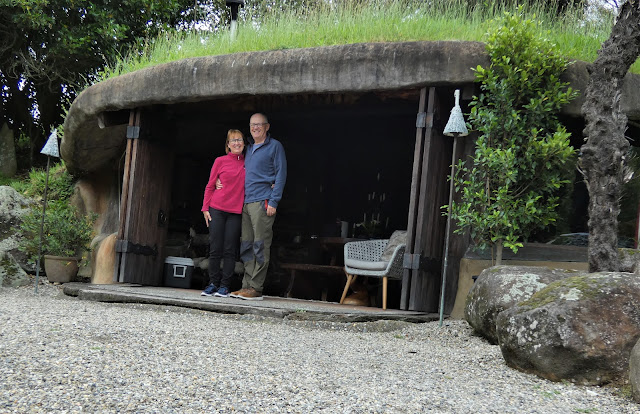 |
| https://www.canopycamping.co.nz/underhill-valley |
On the way we stopped off at Underhill Valley, in Waikato for a special night away in a delightful Hobbit Hole.
 |
| Our own little hobbit hole, deep in the Waikato countryside - just for one night. |
The Coromandel is famous for its beauty, a superlative I have ended up using a lot in New Zealand, which seems to excel in the 'Wow Factor!' at every turn in the road, and I hope these few pictures do it justice.
 |
| A view along the Coromandel Coast during one of our coastal path walks. |
 |
| Cathedral Cove is a bit of a tourist magnet with seemingly everyone, including us, wanting a selfie under that archway, seen at the end of the beach |
 |
| A memorial to Captain Cook stands close to the beach with information about the famous explorer's visit |
 |
| I took some pictures of this amazing 1:5 scale model of the Endeavour in the Russell Museum, built in 1969 to commemorate Cook's first visit to the islands. |
Whilst in the area, we passed through the beautiful town of Thames, what did I say about superlatives?
 |
| Statue of Air Chief Marshall, Sir Keith Park, leader of 11 Group in the Battle of Britain, and Air Officer Commander in Malta from July 1942. A great leader and commander and son of Thames |
The town is the birthplace of Air Chief Marshal Sir Keith Park, mentioned above, and it was very fitting that we passed through it on Remembrance Sunday, when the veterans were on parade at the town hall for the minute silence, which was in fact several minutes and for which I duly removed my cap and paid my respects.
 |
| An early model 25-pounder howitzer, lacking the later models muzzle break, outside the townhall of Thames on Remembrance Sunday. |
Whilst there I grabbed a few pictures of the great man himself, or rather his statue in the town centre, together with the 25-pounder gun in the town square and a replica Hurricane in Battle of Britain colours next to the town airfield and Air Training Corps Meeting Hall.
 |
| The replica Hurricane in Battle of Britain colours towers over the airfield perimeter buildings and is easily seen as you enter Thames, so I stopped for a few pictures despite the rain. |
The rain in the pictures from Thames were the front of a very tricky cyclone that crossed the Coromandel just as we left the area, bringing mudslides that blocked several roads, that we just managed to avoid, making our way to much better weather in Rotorua (4), via another little detour to Hobbiton and perhaps one of the most famous places in New Zealand, certainly if not one of the most famous addresses.
 |
| Bag End with that famous tree atop it. |
I have to admit, that Hobbiton might have failed to live up to its billing and left one slightly underwhelmed by just another theme park looking to sell related trinkets, and yes that element is there as this is a commercial interest with bills to pay.
That said, the whole tour around the site was fun, interesting and informative with some great anecdotes about how the filming was done and pointing out the amazing attention to detail that has made Sir Peter Jackson rightly famed, with the fake tree above Bag End and its thousands of airbrushed leaves.
Suitably refreshed with a jar of the Green Dragon's finest, we were off to Rotorua, the centre of thermal spring activity in North Island and a great place to learn more about the indigenous peoples of New Zealand and Maori culture.
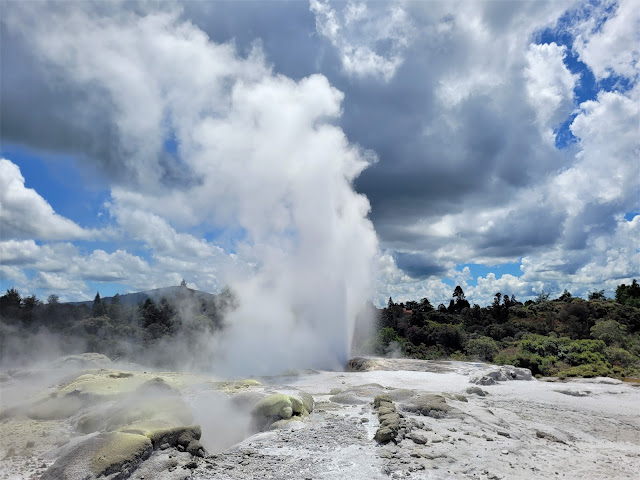 |
| The Pohutu Geyser in the Te Whakarewarewa Valley puts on a display during our visit to the Te Puia Maori Arts & Crafts Institute in Rotorua. https://www.tepuia.com/about-us/ |
 |
| Public parks are not quite the same as in other towns! |
Our trip to Rotorua was all about getting the blend of education and cultural learning with visits booked to the Te Puia Maori Arts & Crafts Institute, and later in the evening a cultural and dining experience at the Te Pa Tu Maori Village.
 |
| I just want you to know the extra mile I'm prepared to go in the preparation of this blog, which included trying out the Polynesian Spa in Rotorua, to ensure that it was all that it is cracked up to be - one happy blogger. https://www.polynesianspa.co.nz/ |
Into the mix was added the pleasure of taking full advantage of the thermal waters in Rotorua with a visit the next day to the wonderful Polynesian Spa for a relaxing plunge followed by a massage and light lunch - living the dream as they say!
The Te Puia Maori Arts & Crafts Institute provides an excellent opportunity to meet with experts in Maori crafts and culture, and to witness the amazing craftwork of carving in wood and stone and the traditional weaving skills using traditional tools and methods; skills that are being passed on to future generations of young Maori.
In addition the Institute allows visitor access to the Te Whakarewarewa Valley with an opportunity to see the many geysers and hot pools that fill the seventy hectare site together with a Kiwi experience, seeing captive birds in darkened enclosures, part of the Kiwi conservation work that seeks to preserve and reintroduce these threatened birds back into the wider environment once pest control activities have significantly reduced the threat to them.
The other cultural experience mentioned was our evening visit to the Te Pa Tu Maori Village where our elected chiefs were challenged in the traditional Maori way of ensuring visitors come in peace, with the traditional challenge from a Maori warrior laying down a fern frond that was required to be picked up in response to confirm our group good intent.
This was followed by a formal greeting by the village chief who welcomed us all into the village to taste traditional Maori delicacies, play traditional games and see the different plants used for medicine and clothing.
We then enjoyed an evening of song and dancing culminating in the traditional performance of the Haka before heading off for a dinner of prepared meats and vegetables cooked in the hangi method of food placed on hot rocks and buried in a pit oven called an umu.
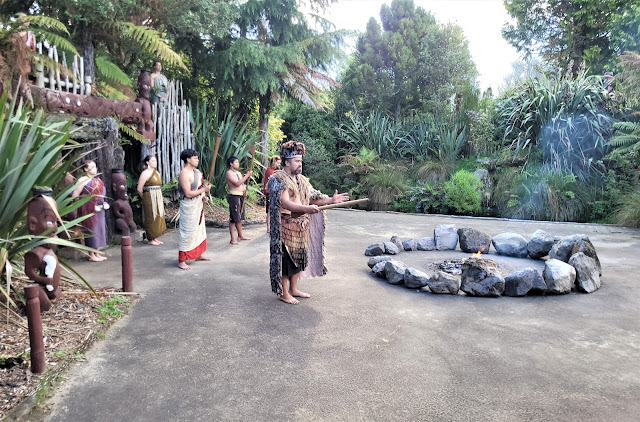 |
| Our formal welcome to the Te Pa Tu Maori Village, a superb evening enjoyed by all. https://te-pa-tu.com/ |
I would like to thank the lads and lasses at the Te Pa Tu Maori Village for giving us all an amazing experience, delivered with respect for cultural traditions mixed with a generous helping of fun and laughter, and I know we all had a great evening.
After the delights of Rotorua we were on the road again, this time heading for the Tongariro National Park (5), New Zealand's oldest national park, established in 1887, and a UNESCO World Heritage Site, to stay at the Chateau Tongariro in preparation for making the day long Tongariro Alpine Crossing, about a twelve mile hike over a saddle between two volcanic peaks.
The Chateau Tongariro was completed in 1929 and retains all the style and chic of the pre-depression era that encompassed the optimism of the new and modern, following the horrors of the First World War, with rail and motor transport offering even greater opportunities to enjoy leisure and travel, primarily for the wealthier classes.
I have to admit that we prepared ourselves for this walk with quite a bit of walking long and mid distances at home over Dartmoor and other such hilly places, but were still very much imbued with a sense of eager anticipation coupled with a mild anxiety to be able to complete this rather long and challenging climb and descent over some very challenging terrain.
In addition, there is the added spice of walking over what is a still very active geo-thermal area with the threat of volcanic activity ever present.
 |
| One does not simply walk into Mordor - Tongariro, another of the classic film locations used by Sir Peter Jackson in Lord of the Rings. https://www.tongarirocrossing.org.nz/ |
Sir Peter Jackson filmed in the area and used Mount Ngauruhoe as his adapted Mount Doom to capture the foreboding terrain of Mordor that confronted the hobbits Sam and Frodo.
In the end all anxieties were quickly overcome as we both settled into our walking rhythm under the guidance of our very capable guides, Stewart and Wayne who helped maintain the pace of our little group with much good humour and casual chat.
The day seemed to fly by, although the limbs were definitely feeling it by the time we got to the bus after our eight hour trek, and we were both glad we had the following day arranged to take it easy lounging around in the Chateau.
 |
| On the descent nearly everyone had the walking poles out to cope with the really loose scree seen in this picture. |
As well as a bit of R&R at the Chateau we kept the limbs moving with some shorter less strenuous walking in the area of the hotel which included another Lord of the Rings adapted location, this time the Tawhai Falls perhaps better known as Gollum's Pool.
 |
| Tawhai Falls perhaps better known as Gollum's Pool |
After getting our breath back after Tongariro it was time to get back on to the road and head out to New Plymouth, again making a slight detour en route to take in the National Army Museum at Waiouru, which I looked at in the post looking at its collection of items from the New Zealand Wars and the Taranaki War.
However the NAM collection also gives a really interesting slant on WWI and WWII themes with a Kiwi perspective not so familiar in the UK, as well as looking at the development of the modern day New Zealand Army which mirrors that in the UK with the move to smaller much more professional type forces.
 |
| National Army Museum at Waiouru, a slight diversion on our way to New Plymouth |
WWI was the coming of age for the Dominion forces of Canada, Australia and New Zealand with the latter two having developed close working relations in the Boer War which saw Australian and NZ light cavalry operating in very familiar terrain against similarly equipped light mounted troops.
However WWI saw the mass mobilisation of Dominion troops and the horrors of modern industrial warfare brought home to these smaller, younger nations, with a similar effect on the folks back home as experienced by families in the UK, and of course the establishment of the Australian, New Zealand Army Corps or ANZAC's and their bitter introduction to those horrors in the Dardanelles campaign, February 1915 - January 1916.
 |
| A very nice display outlining the deployment of the Australian-New Zealand Division in ANZAC cove |
The NAM also had a nice WWII collection of items that covered the European, North African and Pacific theatres that NZ troops operated in with some nice displays covering key theatres, that leads the visitor through to more recent conflicts.
The time spent exploring Taranaki has been covered in the previous two posts linked above, and so following our trip to the Tawhiti Museum we were on our way over to the east coast again to take a look at Napier (8) but not before a bit of messing about in boats at the River Valley Lodge on the Rangitikei River near to Taihape (7) where we based ourselves.
 |
| 'All the gear, no idea' Yours Truly kitted up for our little paddle along the Rangitikei River. Are you sure this is a good idea? |
But that stupid kid that surfaces in me quite regularly immediately piped up, discounting any problems and demanding we just get on with it and have some fun getting wet.
 |
| There you go, this is a lot of fun. |
Kiwi's love the great outdoors, and if they are not walking over volcanos, throwing themselves off bridges on bungees, then they're hurtling along rivers on rafts and jet boats, and I have to say that it is a lot of fun that appealed to my 'big kid'.
 |
| Napier looking like a war zone, lies in ruins after the 1931 earthquake |
This was not originally on the itinerary, but when we saw a video covering the amazing history of this town and its beautiful collection of mostly Art Deco and some Art Nouveau buildings that replaced those lost in the terrible destruction caused to the town on the 3rd February 1931 by the 7.8 magnitude earthquake that struck it that day, we were both very keen to visit this time capsule of a location.
 |
| This is not a film set but beautiful Napier and the amazing buildings created in the wake of the terrible earthquake of 1931 that changed the look of the place in so many ways. |
At 07.50 February 3rd 1931, the Acacia class sloop, HMS Veronica, a veteran of WWI, tied up to the harbour in Napier, ahead of schedule, for a series of planned events in the afternoon, when the ship had been due to arrive.
Shortly before 10.45 Veronica's captain, Commander H. L. Morgan DSO, met with the harbour master to organise his official visits of the day.
At 10.46 an earthquake measuring 7.8 on the Richter scale shook throughout New Zealand, with its epicentre just 9.4 miles north of Napier.
Commander Morgan described the event to the New Zealand Herald;
'I was just leaving my cabin . . . when I heard a terrific roar. The ship heaved and tossed. For about ten seconds I stood still and then ran onto the boat deck. I could see houses falling and roads cracking. Everything seemed to disappear in a cloud of dust.'
It was fortunate that Veronica was calling into Napier when the earthquake struck, as the navy was at the forefront of organising rescue work and helping to recover injured from the wrecked and later burning buildings set on fire in the damage, wafted by an onshore breeze; and to organise immediate relief to shocked and later hungry civilians, whilst also alerting the authorities to the help that Napier would need.
 |
| Comparison Map of the Ahuriri Lagoon, before and after the 1931 earthquake https://commons.wikimedia.org/wiki/File:Ahuriri_Lagoon_map_before_after_1931_Hawke%27s_Bay_earthquake_crude.png |
The aftermath of the earthquake caused 258 deaths and saw an uplift in the area of just short of nine feet, that drained much of the Ahuriri Lagoon making new land available for farms, industry, housing and the Napier airport.
On the 11th March 1931 the NZ government appointed magistrate J. S. Barton and engineer L. B. Campbell as commissioners for Napier and together with a local committee the two men masterminded and organised the rebuilding project of new buildings and the infrastructure to support them.
Four rival architectural practices joined to share resources and ideas, with influences covering designs by Frank Lloyd Wright, Spanish Mission type buildings popular in California, but the majority being of the Art Deco influence, with some of Napier's most striking art deco buildings being designed by E. A. Williams.
Many of these 1930's buildings have now been restored to their former glory and serve as a major tourist attraction to the town with guided tours available with suitably costumed guides or being driven around town in period motor cars, whilst the town also celebrates its inheritance with periodic costumed galas and gatherings.
After imbibing the delights of Napier's history and architecture, and with Carolyn imbibing some of the local wines, we were off to our final destination in North Island, the third and final capital of the country, Wellington (9) named in honour of the First Duke, victorious at Waterloo, and home to the seat of New Zealand's Government and its Parliament, also the Weta Studio and the Museum of New Zealand, amongst other attractions.
 |
| Where modern New Zealand began, with Queen Elizabeth II unveiling this monument, back in 1970, for the bicentenary of Captain Cook's first voyage of discovery in 1769. |
 |
| A nice recognition by the old country for the valour of those from the new. Very few are recognised for their valour with a Victoria Cross, with only 1,358 so recognised since its inception in 1856. |
 |
| A monument recording the centenary of women's suffrage in New Zealand on the 19th September 1893, giving New Zealand the proud record of being the first modern democracy to grant women the vote. |
On our way to a very nice restaurant on the harbour front in Wellington, I caught sight of a naval vessel manoeuvring in preparation to enter the harbour and being met by two tugs to help guide her in.
After a little bit of homework on the New Zealand Navy, it turns out that this is the Anzac-class frigate Te Mana, translating to 'Status' or 'Authority', one of eight such vessels built for Australia and New Zealand, and just two of them serving the the Royal New Zealand Navy.
 |
| Pennant number F111 identifies the ship as Anzac-class frigate Te Mana. |
She has a recorded maximum speed of 27 knots and is armed with one 5"/54 (127mm) Mark 45 Mod 2 gun and a mixture of one Phalanx CIWS and multiple Browning M2 50cal machineguns for close defence.
Back in 2018, HMNZS Te Mana showed her metal during that year's RIMPAC exercise with allied navies in the Pacific by winning the Naval Surface Fire Support Rodeo, which saw her land her shells closer to the target than any other ship in the fleet.
We opted for a guided tour of the studio where I discovered that Weta is a lot more than just Lord of the Rings, with several major film credits going back to the eighties and special effects work covering a wide range of genres that have made it a go-to facility in the film industry.
We got to see some of the other stuff being worked on, with my eye immediately drawn to a picture of a full size mock up of a Lancaster bomber that revealed their involvement in the deferred remake of the Dambusters, although seeing the state of Hollywood and a lot of other producers, one has to wonder whether identity politics would permit such a film to be made these days, that is with any sense of authenticity to the actual story.
In addition, I had a great tour around memory lane through their involvement with the remake of the Jerry Anderson original ‘Thunderbirds’ originally done in the 60’s using marionette puppets but now done with a CGI cast of characters made to appear as if interacting with the giant models of Tracey Island and the various crafts used by International Rescue, Jeff Tracey and family, and not forgetting Lady Penelope and Parker.
Seeing the large models in an even larger hanger-like studio was a real blast from the past, and I regressed to the age of about six in a matter of minutes.
Of course any visit to Weta is going to include a love of the Tolkien inspired movies created by Sir Peter Jackson, but brought to life by the creative abilities of the artists at Weta with an amazing display of their skills on show in their public galleries plus the ability to chat with some of the guys and gals working out back, willing to show off their undoubted modelling skills and techniques.
The links between Weta, and indeed Peter Jackson extend into other creative projects in New Zealand and both names have cropped up again and again in our travels, with one such link emphasised during our tour of Weta when we were shown examples of giant WWI weapons that were constructed as part of the studio's commission to produce a series of giant figures, and I mean GIANT to facilitate a WWI Gallipoli display at the Wellington Museum.
This display has to be seen to be believed to realise the realism captured in each giant sized manikin designed to portray real characters who took part in the ghastly battles that characterised the New Zealand experience of Gallipoli.
The attack began on the 6th August, 1915 with two columns of the New Zealand Infantry Brigade. A morning attack by the Auckland Battalion was repulsed, but a second assault by the Wellington's the following night was successful and the summit was occupied before dawn on the 8th.
With sunrise came a barrage of fire from the Ottoman Turks holding higher ground to the north, and a desperate struggle ensued to hold Chunuk Bair.
By the time the Wellington's were relieved that night only seventy men remained standing from the 760 man battalion that made the initial attack, with their commander, Lieutenant-Colonel William Malone, one of the casualties, killed by an Allied shell at 5pm.
Ottoman troops recaptured the position on the 10th from British troops who had relieved the Wellington's with the 6th South Lancs. and 5th Wilts., practically annihilated in the final Ottoman assault led by Mustafa Kemal.
My paternal Uncle, who was a Japanese prisoner of war on the Burma railway, lost his father at Gallipoli and I was thinking of our conversations before he passed away in 2010, that prompted me to leave a poppy in remembrance of our chat, that made this very special memorial such an impactful one for me.
North Island, New Zealand will always have a very special place in both mine and Carolyn’s hearts, not just for the amazing few weeks we spent touring in such a beautiful part of the world and the amazing places we visited and the sights we enjoyed, but also for the delightful company we had on our journey, and particularly the Kiwi’s we met who were so pleased to welcome visitors and who we found shared a very common sense of humour that made us feel very much at home.
More Anon
JJ




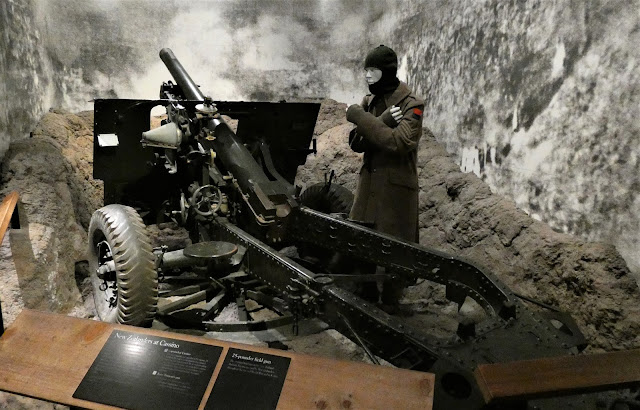









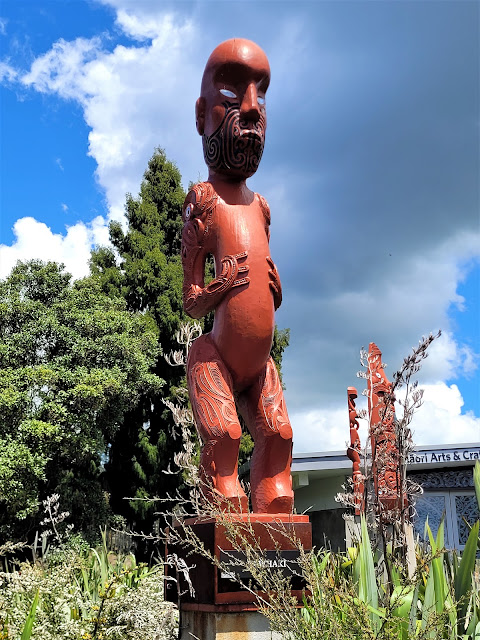







































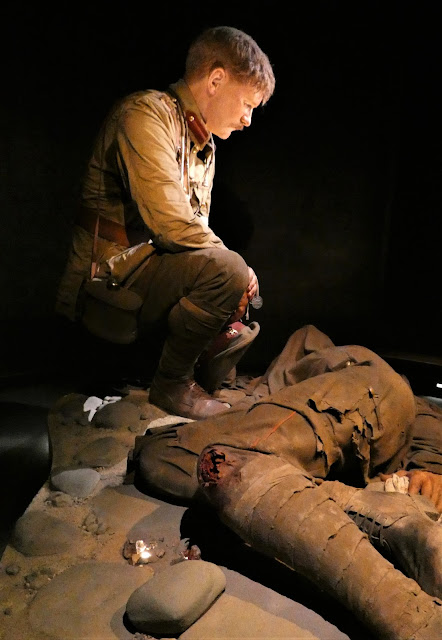







Another great post JJ - people who follow my blog often accuse me of working for the NZ Tourism Board, because I intersperse my toy soldiers with occasional posts about bush walks or trips I make around the country - but I have never managed anything as comprehensive as you have done in these three recent posts - one more covering the S Island to come, I presume? I am looking forward to it!
ReplyDeleteBrilliant post JJ. New Zealand truly is a paradise and a must visit for a holiday soon. I’ve been to Wellington and Auckland for work however that was many years ago. You’ve really piqued my keenness once again.
ReplyDeleteI knew that Australia is a paradise, but your photos now will help me to plan a holiday there myself. Thanks for sharing them!
ReplyDeleteHi Chaps,
ReplyDeleteThank you for your comments, very much appreciated, as I had a lot I wanted to include in that post and it turned out a bit longer than I anticipated.
Yes I intend to do something similar for South Island, and it will definitely be more than one post, as I have another focus on another Sir Peter Jackson exhibition, and of course the beauty and splendour that is South Island.
In the mean time Carolyn and I are looking forward to our first Kiwi Christmas down under and it's all feeling quite a bit different than usual!
Happy Xmas
JJ
Thank You
ReplyDeleteHi,
DeleteMy pleasure, glad you enjoyed the read.
Your comment caused me to have a read myself a recall a wonderful time.
Cheers
JJ